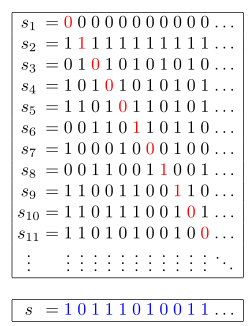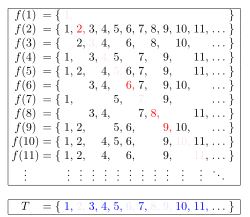Cantor's diagonal argument

In set theory, Cantor's diagonal argument, also called the diagonalisation argument, the diagonal slash argument, the anti-diagonal argument, the diagonal method, and Cantor's diagonalization proof, was published in 1891 by Georg Cantor as a mathematical proof that there are infinite sets which cannot be put into one-to-one correspondence with the infinite set of natural numbers.[1][2]: 20– [3] Such sets are now known as uncountable sets, and the size of infinite sets is now treated by the theory of cardinal numbers which Cantor began.
The diagonal argument was not Cantor's
However, it demonstrates a general technique that has since been used in a wide range of proofs,[6] including the first of Gödel's incompleteness theorems[2] and Turing's answer to the Entscheidungsproblem. Diagonalization arguments are often also the source of contradictions like Russell's paradox[7][8] and Richard's paradox.[2]: 27Uncountable set
Cantor considered the set T of all infinite
- If s1, s2, ... , sn, ... is any enumeration of elements from T,[note 2] then an element s of T can be constructed that doesn't correspond to any sn in the enumeration.
The proof starts with an enumeration of elements from T, for example
s1 = (0, 0, 0, 0, 0, 0, 0, ...) s2 = (1, 1, 1, 1, 1, 1, 1, ...) s3 = (0, 1, 0, 1, 0, 1, 0, ...) s4 = (1, 0, 1, 0, 1, 0, 1, ...) s5 = (1, 1, 0, 1, 0, 1, 1, ...) s6 = (0, 0, 1, 1, 0, 1, 1, ...) s7 = (1, 0, 0, 0, 1, 0, 0, ...) ...
Next, a sequence s is constructed by choosing the 1st digit as complementary to the 1st digit of s1 (swapping 0s for 1s and vice versa), the 2nd digit as complementary to the 2nd digit of s2, the 3rd digit as complementary to the 3rd digit of s3, and generally for every n, the nth digit as complementary to the nth digit of sn. For the example above, this yields
s1 = (0, 0, 0, 0, 0, 0, 0, ...) s2 = (1, 1, 1, 1, 1, 1, 1, ...) s3 = (0, 1, 0, 1, 0, 1, 0, ...) s4 = (1, 0, 1, 0, 1, 0, 1, ...) s5 = (1, 1, 0, 1, 0, 1, 1, ...) s6 = (0, 0, 1, 1, 0, 1, 1, ...) s7 = (1, 0, 0, 0, 1, 0, 0, ...) ... s = (1, 0, 1, 1, 1, 0, 1, ...)
By construction, s is a member of T that differs from each sn, since their nth digits differ (highlighted in the example). Hence, s cannot occur in the enumeration.
Based on this lemma, Cantor then uses a proof by contradiction to show that:
- The set T is uncountable.
The proof starts by assuming that T is countable. Then all its elements can be written in an enumeration s1, s2, ... , sn, ... . Applying the previous lemma to this enumeration produces a sequence s that is a member of T, but is not in the enumeration. However, if T is enumerated, then every member of T, including this s, is in the enumeration. This contradiction implies that the original assumption is false. Therefore, T is uncountable.[1]
Real numbers
The uncountability of the
An injection from T to R is given by mapping binary strings in T to
Constructing a bijection between T and R is slightly more complicated. Instead of mapping 0111... to the decimal 0.0111..., it can be mapped to the base b number: 0.0111...b. This leads to the family of functions: fb (t) = 0.tb. The functions f b(t) are injections, except for f 2(t). This function will be modified to produce a bijection between T and R.
| Construction of a bijection between T and R |
|---|
|
This construction uses a method devised by Cantor that was published in 1878. He used it to construct a bijection between the countably infinite subset from each of these sets so that there is a bijection between the remaining uncountable sets. Since there is a bijection between the countably infinite subsets that have been removed, combining the two bijections produces a bijection between the original sets.[9]
Cantor's method can be used to modify the function f 2(t) = 0.t2 to produce a bijection from T to (0, 1). Because some numbers have two binary expansions, f 2(t) is not even 1/4 + 1/8 + 1/16 + ... = 1/2, so both 1000... and 0111... map to the same number, 1/2.
To modify f2 (t), observe that it is a bijection except for a countably infinite subset of (0, 1) and a countably infinite subset of T. It is not a bijection for the numbers in (0, 1) that have two binary point in the binary expansions of 0, 1, and the numbers in sequence r. Put these eventually-constant strings in the sequence: s = (000..., 111..., 1000..., 0111..., 01000..., 00111..., 11000..., 10111..., ...). Define the bijection g(t) from T to (0, 1): If t is the nth string in sequence s, let g(t) be the nth number in sequence r ; otherwise, g(t) = 0.t2.
To construct a bijection from T to R, start with the tangent function tan(x), which is a bijection from (−π/2, π/2) to R (see the figure shown on the right). Next observe that the linear function h(x) = πx – π/2 is a bijection from (0, 1) to (−π/2, π/2) (see the figure shown on the left). The composite function tan(h(x)) = tan(πx – π/2) is a bijection from (0, 1) to R. Composing this function with g(t) produces the function tan(h(g(t))) = tan(πg(t) – π/2), which is a bijection from T to R. |
General sets

A generalized form of the diagonal argument was used by Cantor to prove Cantor's theorem: for every set S, the power set of S—that is, the set of all subsets of S (here written as P(S))—cannot be in bijection with S itself. This proof proceeds as follows:
Let f be any
- T = { s ∈ S: s ∉ f(s) }.
For every s in S, either s is in T or not. If s is in T, then by definition of T, s is not in f(s), so T is not equal to f(s). On the other hand, if s is not in T, then by definition of T, s is in f(s), so again T is not equal to f(s); cf. picture. For a more complete account of this proof, see Cantor's theorem.
Consequences
Ordering of cardinals
With equality defined as the existence of a bijection between their underlying sets, Cantor also defines binary predicate of cardinalities and in terms of the existence of injections between and . It has the properties of a preorder and is here written "". One can embed the naturals into the binary sequences, thus proving various injection existence statements explicitly, so that in this sense , where denotes the function space . But following from the argument in the previous sections, there is no surjection and so also no bijection, i.e. the set is uncountable. For this one may write , where "" is understood to mean the existence of an injection together with the proven absence of a bijection (as opposed to alternatives such as the negation of Cantor's preorder, or a definition in terms of
Assuming the
In the absence of excluded middle
Also in
It is however harder or impossible to order ordinals and also cardinals, constructively. For example, the Schröder–Bernstein theorem requires the law of excluded middle.
In a set theory, theories of mathematics are
Open questions
Motivated by the insight that the set of real numbers is "bigger" than the set of natural numbers, one is led to ask if there is a set whose
Diagonalization in broader context
Analogues of the diagonal argument are widely used in mathematics to prove the existence or nonexistence of certain objects. For example, the conventional proof of the unsolvability of the
Version for Quine's New Foundations
The above proof fails for
- { s ∈ S: s ∉ f(s) }
is not a set — i.e., does not satisfy the axiom scheme. On the other hand, we might try to create a modified diagonal argument by noticing that
- { s ∈ S: s ∉ f({s}) }
is a set in NF. In which case, if P1(S) is the set of one-element subsets of S and f is a proposed bijection from P1(S) to P(S), one is able to use proof by contradiction to prove that |P1(S)| < |P(S)|.
The proof follows by the fact that if f were indeed a map onto P(S), then we could find r in S, such that f({r}) coincides with the modified diagonal set, above. We would conclude that if r is not in f({r}), then r is in f({r}) and vice versa.
It is not possible to put P1(S) in a one-to-one relation with S, as the two have different types, and so any function so defined would violate the typing rules for the comprehension scheme.
See also
- Cantor's first uncountability proof
- Controversy over Cantor's theory
- Diagonal lemma
Notes
- ^ Cantor used "m and "w" instead of "0" and "1", "M" instead of "T", and "Ei" instead of "si".
- ^ Cantor does not assume that every element of T is in this enumeration.
- ^ While 0.0111... and 0.1000... would be equal if interpreted as binary fractions (destroying injectivity), they are different when interpreted as decimal fractions, as is done by f. On the other hand, since t is a binary string, the equality 0.0999... = 0.1000... of decimal fractions is not relevant here.
References
- ^ ISBN 0-19-850536-1.
- ^ ISBN 978-0-521-43069-2.
- ISBN 0070856133.
- JSTOR 2975129
- ISBN 978-0-387-72176-7.
- ^ Russell's paradox. Stanford encyclopedia of philosophy. 2021.
- ^ Bertrand Russell (1931). Principles of mathematics. Norton. pp. 363–366.
- ISBN 0-674-34871-0, pp. 61–62, 65. On page 65, Dauben proves a result that is stronger than Cantor's. He lets "φν denote any sequence of rationals in [0, 1]." Cantor lets φν denote a sequence enumeratingthe rationals in [0, 1], which is the kind of sequence needed for his construction of a bijection between [0, 1] and the irrationals in (0, 1).
- arXiv:1904.09193 [math.LO].
- MR 2104745
- ^ Rathjen, M. "Choice principles in constructive and classical set theories", Proceedings of the Logic Colloquium, 2002
- ^ Bauer, A. "An injection from N^N to N", 2011
- ISBN 978-0-202-30850-0.
- arXiv:2404.01256 [math.LO].
- ^ Robert S. Lubarsky, On the Cauchy Completeness of the Constructive Cauchy Reals, July 2015
External links





























